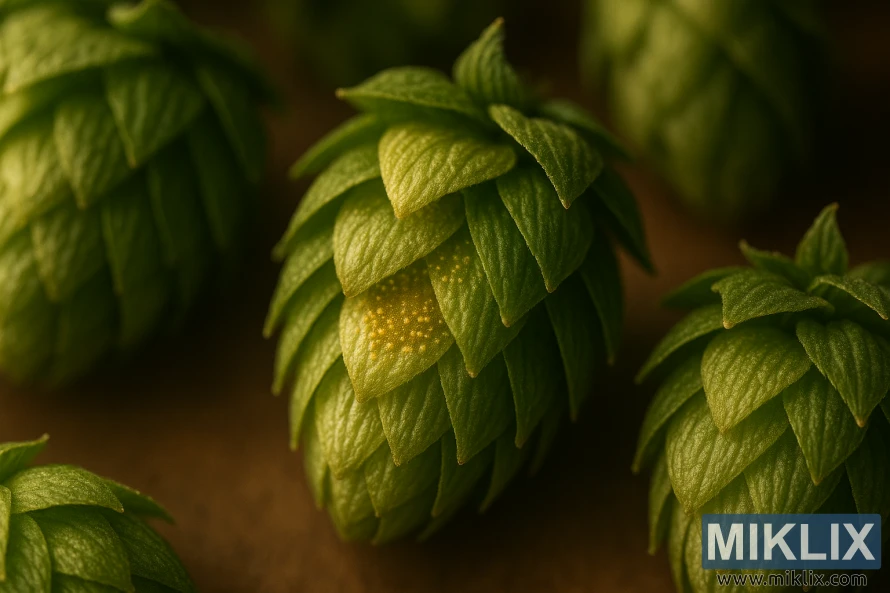Image: Chinook Hops Close-Up
Published: July 31, 2025 at 8:27:58 AM UTC
Last updated: September 27, 2025 at 10:45:25 AM UTC
Close-up of Chinook hops under warm light, showing lupulin glands rich in alpha acids, highlighting their texture and role in brewing bold flavors.
Bathed in a soft, amber glow, the Chinook hop cones in this close-up image emerge as botanical sculptures—each one a marvel of natural engineering. Their overlapping bracts form tight, conical shapes, with surfaces textured like miniature pinecones, yet far more delicate. The cones are captured at a subtle angle, lending a sense of dimensionality that draws the viewer into their intricate structure. Nestled within the folds of one prominent cone is a golden patch of lupulin glands, the treasure trove of brewing alchemy. These tiny, resinous sacs glisten faintly, hinting at the potent alpha acids and essential oils they contain—compounds responsible for the bitterness, aroma, and flavor that define a well-crafted beer.
The lighting in the image is warm and diffused, casting gentle shadows that accentuate the contours of each cone without overwhelming their vibrant green coloration. This interplay of light and shadow evokes a mood of quiet reverence, as if the hops are being presented not merely as ingredients, but as the soul of the brewing process. The background, rendered in a muted brown blur, serves as a subtle canvas that allows the vivid greens and golden yellows of the hops to take center stage. It’s a deliberate compositional choice that keeps the viewer’s attention fixed on the subject, reinforcing the sense of scientific focus and botanical admiration.
What makes this image particularly compelling is its ability to bridge the worlds of art and science. On one hand, it’s a visual celebration of texture, color, and form—a study in organic symmetry and natural beauty. On the other, it’s a nod to the meticulous craft of brewing, where each cone is evaluated for its alpha acid content, oil composition, and aromatic profile. Chinook hops, known for their bold notes of pine, spice, and grapefruit, are a favorite among brewers seeking to create assertive, flavorful beers. The visible lupulin glands in this image are not just aesthetic details; they are the biochemical engines that drive the sensory experience of the final product.
There’s an almost meditative quality to the scene, as if time has slowed to allow for a deeper appreciation of the hop’s anatomy. The viewer is invited to linger, to examine the fine hairs along the bracts, the subtle variations in green tones, and the way the cones seem to pulse with latent energy. It’s a portrait of potential—of what these humble flowers will become once they’re dried, milled, and introduced to boiling wort. In that transformation, the quiet elegance of the hop cone gives way to the bold character of the beer it helps create. And in this moment, frozen in warm light and soft focus, the Chinook hop stands as both muse and catalyst, a symbol of nature’s contribution to human craft.
The image is related to: Hops in Beer Brewing: Chinook

